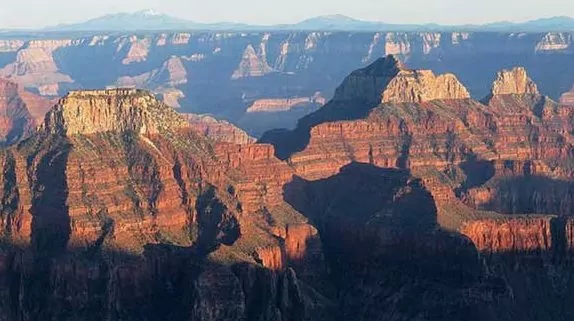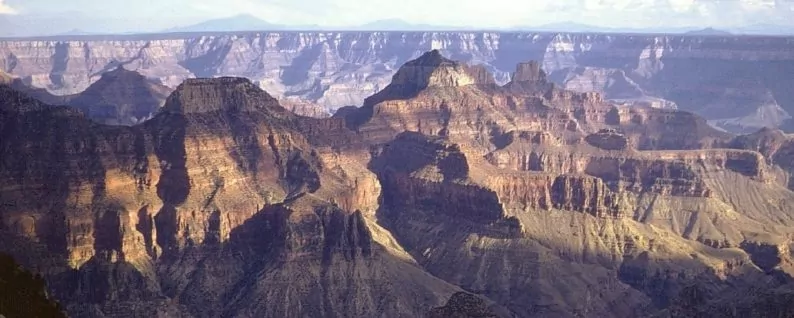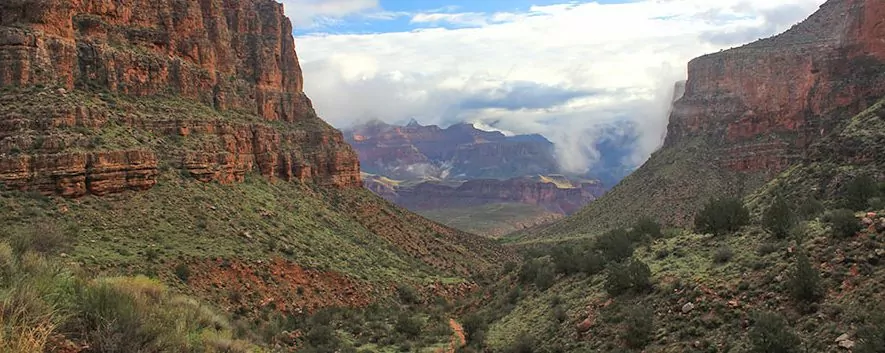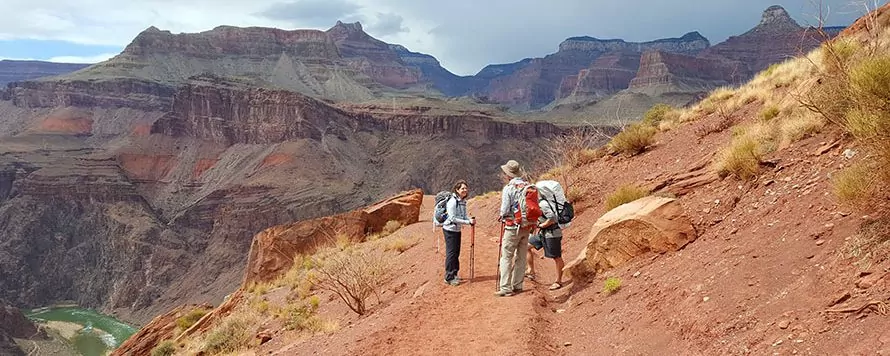
Uncle Jim Trail
From the trailhead, hikers will begin on the trail shared with the Ken Patrick Trail. With a slight incline right off the bat, hikers are rewarded with views of Roaring Spring Canyon and glimpses of the North Kaibab Trail below. The loop trail eventually breaks off from the Ken Patrick Trail, and leads out to Uncle Jim Point. From here, you have a comprehensive view of the canyon. Bright Angel Canyon, the North Kaibab Trail, Zoroaster Temple, the South Rim, Bill Williams Mountain and the San Francisco peaks are all visible from the point. The trail itself is relatively easy with only 230 feet of elevation gain, and is a beautiful stroll through the spruces, firs, aspens and pines.
Explore Grand Canyon with Expert Guides
Getting to the Uncle Jim Trailhead
The trailhead is located on the east end of the parking area for the North Kaibab Trail. It is 2 miles north of the North Rim Lodge on Highway 67.
History of the Uncle Jim Trail
Uncle Jim Trail is named after game warden James T. Owen, whom Theodore Roosevelt hired in 1906 after he created the Grand Canyon Game Preserve. During this era, it was widely believed that predators needed to be eliminated in order for prey and other worthy animals to thrive. Even as a conversationalist, Theodore Roosevelt hunted mountain lions. James T. Owen killed many mountain lions in his time at Grand Canyon, in hopes of benefiting the Kaibab deer population. Not soon after, the deer population skyrocketed to over 100,000, and with so many in the area, they destroyed much of the vegetation. This led wildlife managers to realize the importance of the predator’s role in an ecosystem.
But with so many Kaibab deer on the North Rim, the Secretary of Agriculture, Henry C. Wallace decided to take action in getting rid of some of them. Ideas fluttered around, but eventually, the idea for the “Great Kaibab Deer Drive” was born. In 1924, 50 cowboys and 70 Navajo men saddled their horses in attempts of corralling the deer and forcing them down the North Kaibab, across the Colorado River and relocating them on the South Rim. It is recorded, that once at the rim, not a single deer started into the canyon, and the men discouragingly retreated. New hunting regulations and permits over the next decade gradually thinned out the deer population to an appropriate number.

2 Best Day Hikes on the Uncle Jim Trail
Hiking on the Uncle Jim Trail provides spectacular views into the Grand Canyon and across to the South Rim, while also experiencing the towering Englemann spruce and Douglas firs, as well as the magnificent color of the clusters of aspens. It is truly an awe-inspiring view from the Uncle Jim Trail.
Below are the primary options for day hiking the Uncle Jim Trail:
| Destination | Miles | Elev | Difficulty | Style | |
| Uncle Jim Loop | 4.7 mi | 230 ft | Easy-Moderate | Loop | |
| Ken Patrick Trail | 9.8 mi | 400 ft | Moderate | Through Hike |
1. Uncle Jim Loop
Uncle Jim Trail starts on the same path as the Ken Patrick Trail. Hikers will begin a gentle climb from the trailhead, with views of Roaring Spring Canyon and the North Kaibab Trail. Eventually, the trail leads away from the canyon and into a forest alive with Englemann spruce, Douglas firs and aspens. Just under a mile into the trail, there is a junction, the Ken Patrick trail continuing straight, and ht Uncle Jim Trail going right. Stay to the right here, and the trail dips into a drainage, climbs a short hill and comes to another junction, this is the beginning of the loop trail. The loop takes you to the rim of Bright Angel Canyon and straight to Uncle Jim Point.
From Uncle Jim Point, you are able to see the North Kaibab Trail; Bright Angel Canyon; Zoroaster, Deva and Brahma Temples; the South Rim; Bill Williams Mountain– in the town of Williams; and the San Francisco Peaks of Flagstaff. The loop continues back to the trail where it split, and to get to the trailhead, simply turn and hike out the way you hiked in.
2. Ken Patrick Trail
This trail starts at the same trailhead, and even shares the path for the first mile of the Uncle Jim Trail. At the junction telling hikers to turn right for Uncle Jim, continue straight. The Ken Patrick Trail continues all the way to Point Imperial, which is 9.8 miles one-way to Point Imperial. If possible, it is best to do this with a car shuttle, parking one car at the North Kaibab parking area, and the other at Point Imperial. The trail winds in and out of the spruce, fir and pine forest, with occasional (but absolutely beautiful) views of the canyon. It is a perfect hiking option for those who seek solitude and peace in the trees.
Maximize Your Visit to Grand Canyon on a Day Hiking Tour
Guided day hike tours and multi-day packages allow visitors the opportunity to make the most of their time in Grand Canyon National Park and to do it hassle-free. Guided tours include gear (backpack, trekking poles, crampons in winter), meals, accommodations on multi-day tours, local transportation, and a professional Grand Canyon hiking guide. Through their knowledge, stories, and personal passion, guides can bring a place to life in a way that’s much more difficult to do on your own. Read more about Grand Canyon Hiking Tours.
Award Winning USA Hiking Vacations

3 Backpacking Trips Near Uncle Jim Trail
While the Uncle Jim trail is not typically used for backpacking, you can achieve your North Rim backpacking trip on a nearby trail.
| Route | Miles | Difficulty | Campgrounds | |
| Ken Patrick Trail to Point Imperial | 20.6 mi | Moderate | Use Area NC9 | |
| Rim to Rim | 21 mi | Strenuous | Cottonwood CG Bright Angel CG Havasupai Garden CG |
|
| North Kaibab to Colorado River | mi | Strenuous | Cottonwood CG Bright Angel CG Cottonwood CG |
1. Ken Patrick Trail to Point Imperial (2 days)
The Ken Patrick Trail continues past the junction for the Uncle Jim Trail. It winds through the forest, and the first section has little views of the Grand Canyon. That being said, it provides excellent solitude in the spruce, pine and fir forest. This trail is one of the least traveled trails on the North Rim, making it great for hikers who hope to escape the crowds on a backpacking trip. Starting from the trailhead at the North Kaibab parking area, it is roughly 6 miles through the trees to Cape Royal Road, where the trail intersects the road and continues on the other side.
One possibility is to begin the trail here at Cape Royal Road and skip the first 6 miles through the trees. From here, the trail begins a gentle climb, and at the top, the view opens up to the east where Point Imperial, the Nankoweap Basin and Mount Hayden are visible. The trail goes down one saddle, and right up another, and at the top, the Little Colorado River gorge and the San Francisco peaks are seen. Eventually, the trail ends at the parking area for Point Imperial, the highest point along the rim of the Grand Canyon. In this area is a great spot to pitch your tent and lay beneath the stars. Camping is permitted in Use Area NC9, and does require a backcountry permit.
2. Rim to Rim (4 days)
No bucket list is complete without the iconic Rim to Rim hike. Beginning on the North Rim, hike down the North Kaibab Trail to Cottonwood Camp. On day 2, be mesmerized by the other-worldly beauty of Ribbon Falls. As you continue to descend to the Colorado River, the canyon broadens giving and great views of Oza Butte and the Grand Canyon Supergroup rock layers before the canyon narrows bringing you to the historic Phantom Ranch at the bottom of Grand Canyon. After enjoying a lemonade with your comrades and sending a postcard by mule, set up camp at Bright Angel Campground and enjoy dinner at Boat Beach beach on the banks of the mighty Colorado River, making sure not to miss the Ranger Program at the Ranch.
On day 3 you say goodbye to Phantom Ranch and begin up one of Americas most famous trails, the Bright Angel Trail. Cross the Colorado River via the silver bridge and ascend the glorious Bright Angel through colorful Tapeats sandstone along Garden Creek before taking respite at Havasupai Garden Campground, where deer frolic under the canopy of cottonwood trees in their oasis beneath the cliffs. Follow the 1.5 mile spur trail from Havasupai Gardens to catch sunset at Plateau Point, a true gem of a vista and one of the best viewpoints in Grand Canyon. On day 4, keep an eye out for California condors as you tackle the infamous switchbacks of the Bright Angel Trail before topping out in historic Grand Canyon village.
3. North Kaibab to Colorado River (4 days)
There is truly something special about being at the Colorado River. It helps put the whole canyon in perspective to be up close with the thing that carved it. Begin down the North Kaibab Trail, switchbacks steep and steady as you plunge into the middle of the earth. Camp the first night at Cottonwood, 6.8 miles down the trail. The next morning, you can wake up and take the 1.6 mile hike to Ribbon Falls, an absolute oasis in the desert. Then continue down, into the area called “The Box”, where the trail is boxed on both sides by 1.7 billion year old Vishnu Schist. It is a total of 7.2 miles from Cottonwood Campground to Bright Angel Campground.
Once here, ditch your backpack at your campsite and head to Boat Beach at the Colorado River to watch the rafts go by and soak your sore muscles in the raging river. Stop by the Cantina to mail your postcards home– each is stamped with a Grand Canyon seal and a stamp declaring it was taken out of the canyon on mule-back. Also, make sure to catch the evening ranger program at the Ranch. The third morning, start back up the North Kaibab, the same way you came in, hopefully you will notice something this time that you didn’t notice on the way down. Stay at Cottonwood for your last night, and enjoy the stars while being surrounded by rock. On the morning of your last day, wake early and hike to the trailhead at the North Rim.
Join a Guided Grand Canyon Backpacking Trip
Joining a Grand Canyon backpacking tour is a worry-free, adventurous way to experience Grand Canyon National Park. With your gear, meals, local transportation, permits, and fees taken care of for you, you can travel light and focus 100% on enjoying the hiking experience, while the guide company takes care of everything else. Also, by going with local experts you’ll enjoy a greater level of safety and gain a much better understanding of the history and ecology of this remarkable region. Read more about a guided Grand Canyon backpacking trips.
All-inclusive Grand Canyon Backpacking Adventures

When to Hike and Seasonal Considerations
Grand Canyon’s North Rim is only open May 15th through October 15th because of the amount of snow it receives in the winter. Since it is over 8,000 feet in elevation, the weather may be cooler than you imagine in the spring and fall. There are also monsoon rainstorms during the summer months, they create beautiful clouds and storms, and are nothing to be afraid of, but make sure you know what to do if you see lightning. Check the weather before you head out on any hike.
Necessary Permits
Day Hike Permits
Permits are not required for day hikes in Grand Canyon National Park.
Backpacking Permits
Backpacking permits are required for any backcountry camping. Most backcountry camping along the rim of the North Rim is at large camping, and permits are easy enough to obtain on the day of. Trails that go into the canyon, especially the corridor trails, such as Cottonwood or Bright Angel Creek require reservations and advanced planning. For more information on Grand Canyon’s permit system, click here.
Suggested Packing List
Day Hike Packing List
- 3-6 liters of water (more in summer)
- Salty, calorie-rich snacks
- lunch
- backpack
- trekking poles
- crampons (in winter)
- wide-brimmed hat
- sunscreen, sunglasses
- cotton t-shirt (spring-fall)
- non-cotton t-shirt (winter)
- rain jacket
- warm non-cotton layer
- 1st-aid kit
Backpacking Packing List
- all items listed for day hikes PLUS
- multi-day backpack
- 3-season tent
- sleeping bag
- sleeping pad
- backpacking stove and fuel
- backpacking meals
- 3 pairs wool socks
- extra t-shirts
Please Respect Our National Parks – Leave No Trace
We strongly recommend abiding by all Leave No Trace ethics guidelines and practices so that our national parks and public lands are preserved for the enjoyment of future generations and for the people and animals who call these places home. Simple things like packing out your trash, obeying national park rules, and respecting the peace and quiet of our national park trails is a great start. If you’re going on a backpacking trip, you can read about more about the 7 Leave No Trace Principles.




